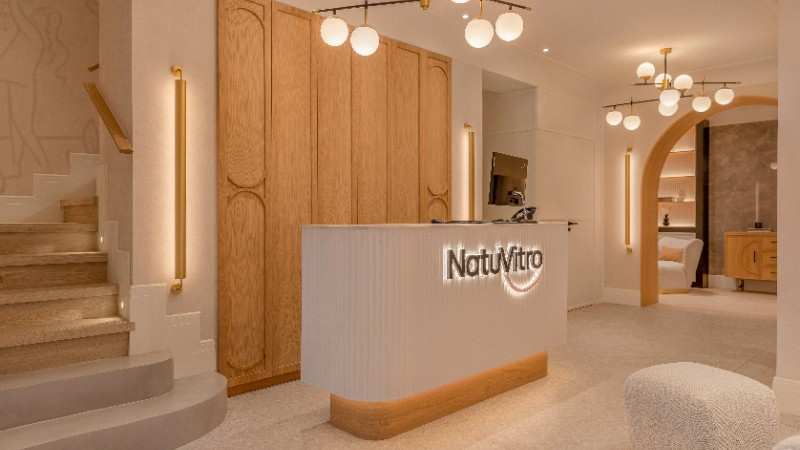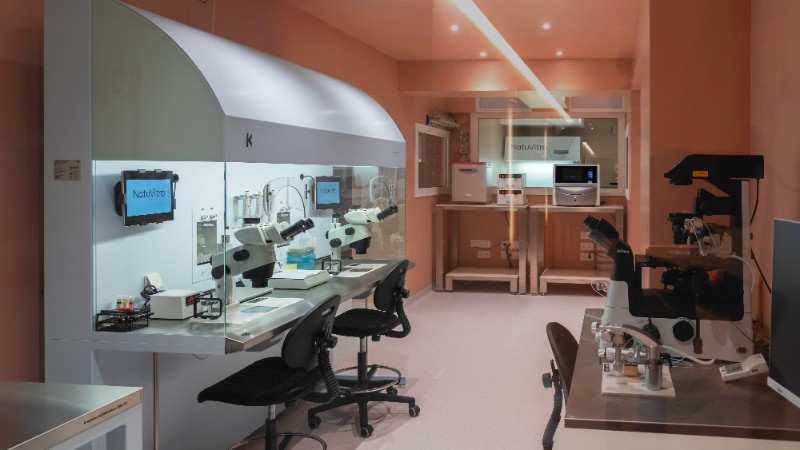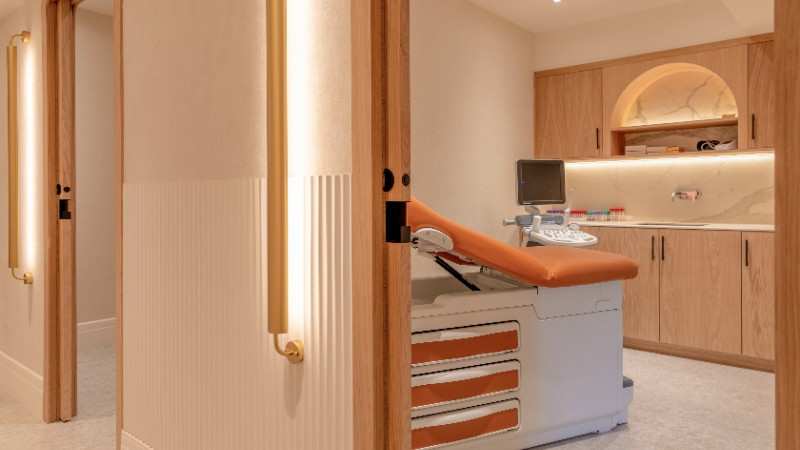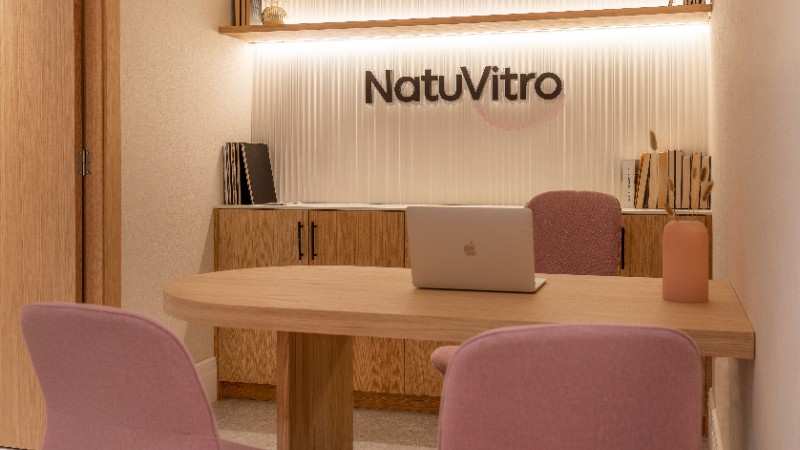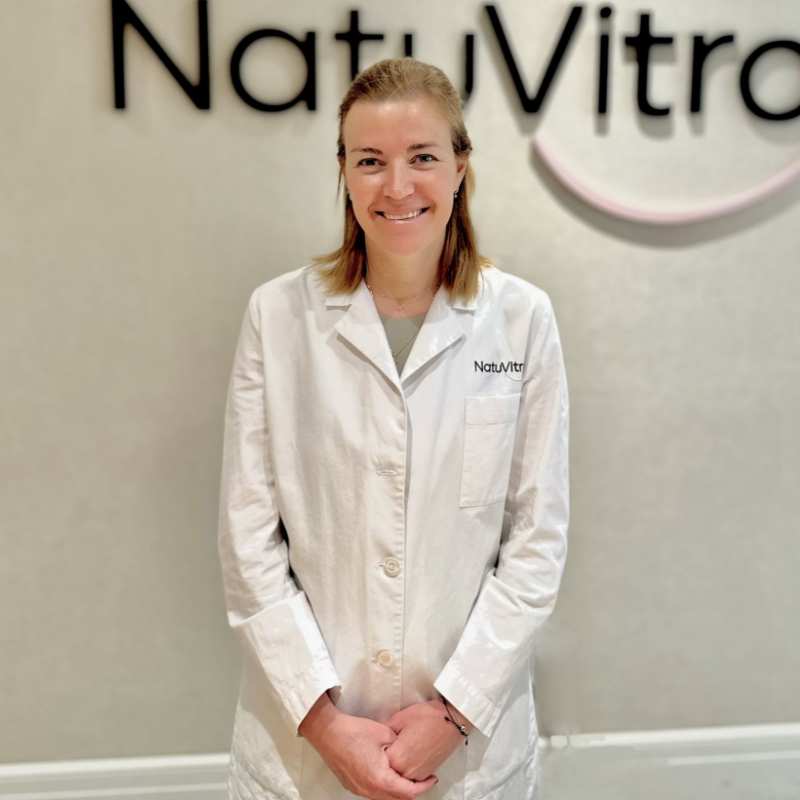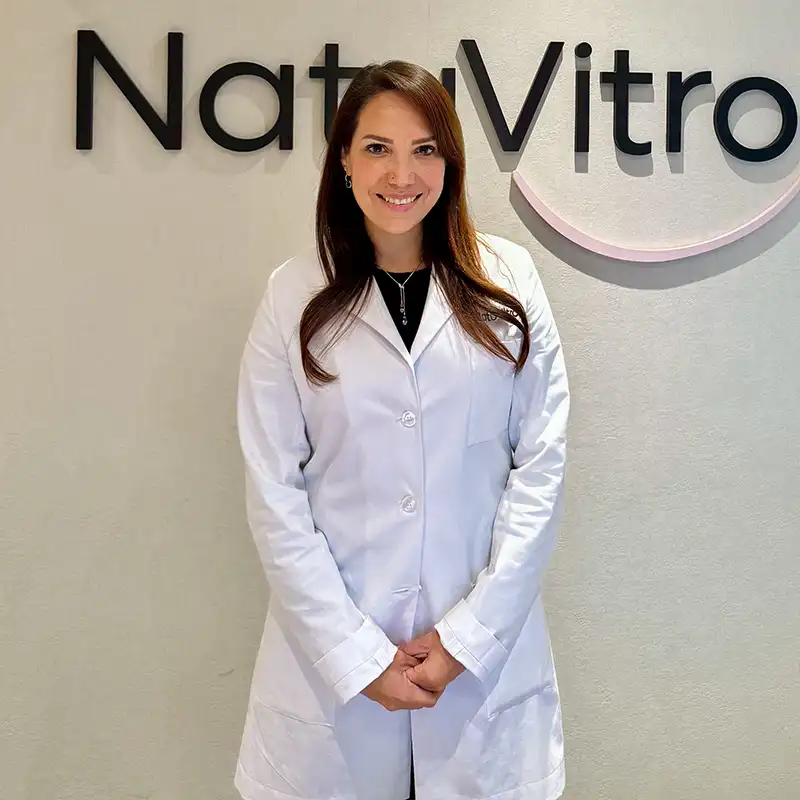
Complex medical procedures and protocols are associated with IVF with egg donation. Our goal is to provide an in-depth understanding of this fertility treatment and its various aspects.
Our journey through this article will cover 4 central topics:
- Preimplantation genetic testing (PGT): The wonders of modern medical science have introduced a revolutionary technique known as preimplantation genetic testing, abbreviated as PGT (or PGT in French). We will explore how PGT plays a vital role in IVF with egg donation, ensuring the health and genetic integrity of embryos, and its profound impact on the success of the procedure.
- Cryopreservation (freezing) in egg donation procedures: Cryopreservation, the process of freezing and storing biological material, has revolutionized fertility treatments, thus increasing the flexibility and success rates of the procedure.
- Endometrial preparation in the natural cycle for egg donation, closely monitoring and leveraging the natural menstrual cycle of the recipient for endometrial preparation. Unlike traditional IVF cycles, where recipients are often subjected to hormonal medications to synchronize cycles, the natural cycle approach aims to align embryo transfer with the physiological rhythm of the recipient. The method involves close monitoring and exploitation of the recipient's natural menstrual cycle for endometrial preparation.
- VOC-free laboratory (Volatile Organic Compounds), the safe environment for the growth of your embryos.
The use of preimplantation genetic testing (PGT) to enhance the success of IVF with egg donation
The world of reproductive medicine has experienced remarkable advances in recent years, and at the forefront of these advances is preimplantation genetic testing (PGT), a revolutionary technique that has transformed the landscape of assisted reproductive technologies. In the context of IVF with egg donation, PGT plays an indispensable role in the framework that the clinic provides, ensuring the health and genetic integrity of embryos and significantly impacting the success of the intervention.
PGT is a sophisticated method that allows comprehensive genetic evaluation of embryos before implantation in the uterus. This evaluation covers a variety of genetic factors, including chromosomal abnormalities and specific genetic disorders. By identifying and selecting embryos with the best genetic profile, PGT increases the chances of a successful pregnancy and the birth of a healthy child.
There are several key aspects of PGT in the context of IVF with egg donation that are worth exploring:
- Chromosomal abnormalities: PGT can identify chromosomal abnormalities in embryos, which are one of the leading causes of implantation failures and miscarriages. By selecting embryos with a normal number of chromosomes, the chances of a successful pregnancy increase significantly.
- Genetic disorders: PGT can also identify specific genetic disorders, allowing prospective parents to avoid passing on hereditary diseases to their children. This aspect of PGT is particularly crucial for couples with known genetic risks.
- Embryonic viability: PGT facilitates the selection of embryos with the highest potential for successful implantation and development. This ensures that the selected embryo is more likely to result in a healthy pregnancy.
- Reduction of multiple pregnancies: PGT allows the transfer of a single embryo with a higher likelihood of success, thereby reducing the risk of multiple pregnancies, which can pose health risks for both the mother and the babies.
The integration of PGT into IVF with egg donation represents a significant step forward in reproductive medicine. Not only does it improve the success rates of the procedure, but it also provides peace of mind to prospective parents knowing that the embryos selected for transfer are of the highest genetic quality.
The use of PGT in IVF with egg donation demonstrates the ongoing advancements in reproductive medicine, providing hope and possibilities to individuals and couples on the path to parenthood. This represents an incredible opportunity to increase the chances of a successful pregnancy and the birth of a healthy child.
Understanding PGT in general:
PGT allows embryologists and healthcare professionals to examine the genetic makeup of embryos created through IVF. This examination is performed before embryo transfer and provides valuable information about the genetic health of the embryos. PGT has three main applications, each with a specific purpose:
PGT-A (Aneuploidy Screening) assesses the number of chromosomes in an embryo. An abnormal number of chromosomes can lead to conditions such as Down syndrome and significantly reduce the chances of a successful pregnancy. By identifying embryos with the correct number of chromosomes, PGT-A helps ensure that only genetically normal embryos are selected for transfer.
PGT-M (Monogenic Disease Testing) is used if there is a known mutation or genetic disorder in the family. It helps identify embryos free of the specific genetic condition, thereby minimizing the risk of transmitting hereditary diseases to offspring.
PGT-SR (Structural Rearrangement Testing) is used when one or both partners have a chromosomal rearrangement, which may lead to recurrent miscarriages or developmental issues. This test allows for the identification of embryos with normal chromosomal structures, thus increasing the chances of a healthy pregnancy, always within the legal framework.
These applications of PGT provide a deep level of understanding about the genetic health of embryos, enabling healthcare professionals to make informed decisions about which embryos to transfer, thereby increasing the likelihood of a successful pregnancy and the birth of a healthy child.
The role of PGT in IVF with egg donation
In the context of IVF with egg donation, the use of PGT has considerable implications. Donated eggs may come from various sources, and PGT allows for a comprehensive evaluation of the genetic health of embryos created from those eggs.
To maximize the chances of a successful pregnancy, PGT identifies embryos with the highest potential for successful implantation and minimizes the risk of transmitting genetic diseases. This increases the chances of a healthy pregnancy and the birth of a genetically healthy child.
This personalized approach enhances the overall success of IVF with egg donation and provides prospective parents with a greater level of confidence and security on their journey to parenthood.
The ability to select genetically healthy embryos significantly reduces the emotional and financial burden of multiple IVF cycles, as well as the risk of miscarriage or the birth of a child with genetic disorders.
In clinics like NatuVitro, PGT is an integral part of the IVF process with egg donation. The incorporation of PGT ensures that all necessary measures are taken to optimize outcomes and make the dreams of those seeking to expand their family a reality.
The role of cryopreservation (freezing) in enhancing the success and flexibility of egg donation procedures
The field of reproductive medicine has exponentially evolved in recent years, introducing innovative techniques that have revolutionized fertility treatments. One such revolutionary advancement is cryopreservation, commonly known as egg freezing. In the context of egg donation procedures, cryopreservation plays a central role, offering a wide variety of benefits that optimize success rates and provide invaluable flexibility to patients on their journey to motherhood.
Cryopreservation involves freezing and storing eggs or embryos for future use. In IVF with egg donation, this technique offers several advantages:
- Increased flexibility: Cryopreservation allows the preservation of donor eggs for an extended period. This provides flexibility in coordinating egg retrieval, fertilization, and embryo transfer. It also allows for precise timing to align with the recipient's cycle, thus optimizing the chances of a successful pregnancy.
- Reduced stress and pressure: Immediate use of fresh eggs can create time constraints and stress. Cryopreservation alleviates this pressure, allowing the donor and the egg recipient to proceed at a pace that best suits their individual needs.
- Risk mitigation: By freezing the eggs, the risk of not recovering eggs or experiencing low egg production is mitigated. This ensures that there is a sufficient quantity of quality eggs available when needed for fertilization.
- Minimized cost: Cryopreservation can reduce the overall cost of IVF with egg donation. It eliminates the need for repeated egg retrieval procedures and associated costs, making fertility treatment more affordable for patients.
- Optimized timing: Cryopreservation allows for precise scheduling of embryo transfer, aligning with the recipient's cycle. This synchronization improves the chances of successful implantation and pregnancy.
This innovative technique, offered in clinics like NatuVitro, illustrates advancements in reproductive medicine and provides hope and possibilities for those on the path to parenthood while adhering to clinical guidelines.
What is cryopreservation?
Cryopreservation, or egg freezing, is a technique that involves preserving biological material, in this case, eggs or embryos, at extremely low temperatures. This process effectively stops the biological clock, allowing eggs to be stored for an extended period without losing viability. Cryopreserved eggs can be thawed and used for fertilization in the future, providing a variety of benefits for both donors and recipients within the clinic's protocols.
The importance of cryopreservation in egg donation procedures
Cryopreservation plays a central role in enhancing the recruitment and synchronization of egg donors, which is a crucial aspect of egg donation procedures. This technique offers a practical solution to a common logistical challenge in the process, ensuring more effective coordination between egg donors and recipients. Timing and synchronization of menstrual cycles are critical for the success of egg donation, and cryopreservation streamlines this process by allowing donated eggs to be preserved until the recipient's uterine lining is optimally prepared for embryo transfer. This flexibility minimizes the risk of cycle asynchrony and contributes to higher success rates.
Additionally, cryopreservation reduces the emotional burden associated with egg donation procedures. It allows donors to undergo the egg retrieval process at their convenience, and recipients can prepare for embryo transfer without the pressure of coordinating schedules with the donor. This leads to a more relaxed and positive experience for all parties involved.
Moreover, cryopreservation minimizes the risk of cycle cancellation, a concern with conventional egg donation. Unforeseen circumstances, such as a poor response to ovarian stimulation or an unexpected lack of donor availability, can lead to cycle cancellation. Cryopreservation greatly reduces this risk because the eggs are readily available for future use. This security provides peace of mind to recipients, ensuring that their path to parenthood remains on track even in the face of unforeseen events.
Endometrial preparation in the natural cycle.
Endometrial preparation in the natural cycle for cryogenic transfer in the treatment of egg donation presents a promising pathway to improve outcomes and patient satisfaction. Physiological synchronization, reduced medication risks, personalized timing for cryogenic transfer, minimal disruption to the natural cycle, cost-effectiveness, and patient-centered care collectively contribute to the appeal of this approach. As advancements in reproductive medicine continue, the emphasis on tailoring treatments to align with the recipient's natural cycle underscores the commitment to optimizing the success of egg donation treatments while prioritizing the well-being of individuals on the path to parenthood.
The benefits of endometrial preparation in the natural cycle for egg donation include:
- Physiological synchronization for optimal receptivity. The natural cycle allows the synchronization of endometrial receptivity with the stage of embryo development in question. This physiological alignment is crucial for maximizing the chances of successful implantation, as the uterus is in its most receptive state during the natural menstrual cycle.
- Reduced drug-related risks for recipients. Recipients of egg donation treatments often appreciate the decreased reliance on hormonal medications. Avoiding or minimizing these medications reduces the risk of side effects, providing a more comfortable and less intrusive experience for women receiving egg donation. • Personalized timeline for cryogenic transfer. Endometrial preparation through the natural cycle allows for a personalized approach to scheduled cryogenic transfer. By leveraging the natural menstrual cycle of the recipient, healthcare providers can optimize the timing of embryo transfer based on the unique physiological characteristics of the individual, potentially improving the chances of successful implantation.
- Minimized disruptions to the recipient's natural cycle. The use of hormonal medications in traditional IVF cycles can disrupt the recipient's natural menstrual cycle. Endometrial preparation for the natural cycle minimizes these disruptions, providing a therapeutic approach that aligns with the recipient's reproductive rhythm.
- Cost-effectiveness and accessibility. Preparing the endometrium in the natural cycle reduces the need for medications, thereby lowering costs.
- Patient-centered care. The natural cycle approach promotes a patient-centered care model.
VOC-free laboratory
As advancements in assisted reproductive technologies continue to reshape the landscape of fertility treatments, one often-overlooked factor plays a central role in the success of egg donation treatments: the environment in which all these procedures take place.
Volatile Organic Compounds (VOCs) are chemical substances that can be emitted as gases from various materials (plastic, coating, wood, paint...), and their presence in laboratory settings can have subtle yet significant effects on the processes involved in IVF treatments. Let us explore the importance of VOC-free laboratories and their substantial impact on the success rates of egg donation treatments.
Understanding VOCs and their impact
VOCs are a diverse group of compounds found in everyday products such as cleaning supplies, paints, and furniture. In the laboratory, the presence of VOCs may stem from laboratory equipment, cleaning products, and building materials. These compounds have the potential to interact with the delicate processes of assisted reproductive technologies, including egg donation treatments, and may negatively impact the success rates of these procedures.
Key benefits of VOC-free laboratories in egg donation
- Optimal conditions for gamete handling: Handling donor eggs and sperm requires a controlled environment free from external contaminants. VOC-free laboratories provide optimal conditions for gamete handling, minimizing the risk of exposure to substances that could compromise the viability of reproductive cells.
- Enhanced embryo culture environment: In vitro fertilization (IVF) involves the culture of embryos in the laboratory prior to transfer. The quality of the culture environment is critical for the success of egg donation treatments. VOC-free laboratories create a pristine environment that reduces the likelihood of contaminants affecting embryo culture, thereby promoting optimal conditions for embryo development.
- Mitigation of potential developmental interferences: VOCs have been associated with toxicity to development and reproduction. In the context of egg donation treatments, mitigating potential developmental interferences is crucial to ensuring the health and viability of embryos. A VOC-free laboratory environment contributes to creating a cleaner and safer space for critical stages of embryonic development.
- Minimized risk of genetic and epigenetic aberrations: Exposure to environmental contaminants, including VOCs, has been associated with genetic and epigenetic abnormalities. By eliminating or significantly reducing VOCs in the laboratory, the risk of genetic and epigenetic aberrations in developing embryos is minimized, thereby improving the overall success rates of egg donation treatments.
- Constant temperature and humidity control: VOC-free laboratories often have advanced temperature and humidity control systems. Maintaining consistent and optimal conditions is essential for the success of assisted reproductive technologies. Fluctuations in temperature and humidity can compromise the viability of eggs and embryos, highlighting the importance of a controlled environment.
- Improved air quality for laboratory staff and patients: Beyond their impact on reproductive cells, a VOC-free laboratory prioritizes the health and well-being of laboratory staff and patients. Improving air quality reduces the risk of respiratory problems and other health issues associated with VOC exposure, creating a safer and more comfortable environment for everyone involved in the egg donation process.
The importance of VOC-free laboratories in egg donation treatments cannot be underestimated. By providing an environment free from harmful contaminants, these laboratories significantly contribute to the success rates of assisted reproductive technologies. The benefits extend beyond the immediate reproductive processes and impact the genetic integrity of embryos, the well-being of laboratory staff, and the overall quality of the treatment experience for patients. As the field of reproductive medicine continues to advance, the role of VOC-free laboratories is becoming a critical factor in ensuring the highest standards of care and success for individuals and couples embarking on the transformative journey of treatment through egg donation.
NatuVitro is proud to be the first IVF laboratory certified VOC-free in Spain, and our success rate speaks for itself. We will continue to raise the bar for technological progress and provide the best outcomes for our patients.
Our experts are ready to examine your case history, clarify your choices, and address every question you have.
Don't wait to make informed decisions – your personalized guidance awaits!
- Spain (España)+34
- France (La France)+33
- Italy (Italia)+39
- United Kingdom+44
- United States+1
- Belgium (België)+32
- Switzerland (Schweiz/Suisse)+41
- Germany (Deutschland)+49
- Netherlands (Nederland)+31
- Afghanistan (افغانستان)+93
- Albania (Shqipëri)+355
- Algeria (الجزائر)+213
- American Samoa+1
- Andorra+376
- Angola+244
- Anguilla+1
- Antigua and Barbuda+1
- Argentina+54
- Armenia (Հայաստան)+374
- Aruba+297
- Ascension Island+247
- Australia+61
- Austria (Österreich)+43
- Azerbaijan (Azərbaycan)+994
- Bahamas+1
- Bahrain (البحرين)+973
- Bangladesh (বাংলাদেশ)+880
- Barbados+1
- Belarus (Беларусь)+375
- Belize+501
- Benin (Bénin)+229
- Bermuda+1
- Bhutan (འབྲུག)+975
- Bolivia+591
- Bosnia and Herzegovina (Босна и Херцеговина)+387
- Botswana+267
- Brazil (Brasil)+55
- British Indian Ocean Territory+246
- British Virgin Islands+1
- Brunei+673
- Bulgaria (България)+359
- Burkina Faso+226
- Burundi (Uburundi)+257
- Cambodia (កម្ពុជា)+855
- Cameroon (Cameroun)+237
- Canada+1
- Cape Verde (Kabu Verdi)+238
- Caribbean Netherlands+599
- Cayman Islands+1
- Central African Republic (République centrafricaine)+236
- Chad (Tchad)+235
- Chile+56
- China (中国)+86
- Christmas Island+61
- Cocos (Keeling) Islands+61
- Colombia+57
- Comoros (جزر القمر)+269
- Congo (DRC) (Jamhuri ya Kidemokrasia ya Kongo)+243
- Congo (Republic) (Congo-Brazzaville)+242
- Cook Islands+682
- Costa Rica+506
- Côte d’Ivoire+225
- Croatia (Hrvatska)+385
- Cuba+53
- Curaçao+599
- Cyprus (Κύπρος)+357
- Czech Republic (Česká republika)+420
- Denmark (Danmark)+45
- Djibouti+253
- Dominica+1
- Dominican Republic (República Dominicana)+1
- Ecuador+593
- Egypt (مصر)+20
- El Salvador+503
- Equatorial Guinea (Guinea Ecuatorial)+240
- Eritrea+291
- Estonia (Eesti)+372
- Eswatini+268
- Ethiopia+251
- Falkland Islands (Islas Malvinas)+500
- Faroe Islands (Føroyar)+298
- Fiji+679
- Finland (Suomi)+358
- French Guiana (Guyane française)+594
- French Polynesia (Polynésie française)+689
- Gabon+241
- Gambia+220
- Georgia (საქართველო)+995
- Ghana (Gaana)+233
- Gibraltar+350
- Greece (Ελλάδα)+30
- Greenland (Kalaallit Nunaat)+299
- Grenada+1
- Guadeloupe+590
- Guam+1
- Guatemala+502
- Guernsey+44
- Guinea (Guinée)+224
- Guinea-Bissau (Guiné Bissau)+245
- Guyana+592
- Haiti+509
- Honduras+504
- Hong Kong (香港)+852
- Hungary (Magyarország)+36
- Iceland (Ísland)+354
- India (भारत)+91
- Indonesia+62
- Iran (ایران)+98
- Iraq (العراق)+964
- Ireland+353
- Isle of Man+44
- Israel (ישראל)+972
- Italy (Italia)+39
- Jamaica+1
- Japan (日本)+81
- Jersey+44
- Jordan (الأردن)+962
- Kazakhstan (Казахстан)+7
- Kenya+254
- Kiribati+686
- Kosovo+383
- Kuwait (الكويت)+965
- Kyrgyzstan (Кыргызстан)+996
- Laos (ລາວ)+856
- Latvia (Latvija)+371
- Lebanon (لبنان)+961
- Lesotho+266
- Liberia+231
- Libya (ليبيا)+218
- Liechtenstein+423
- Lithuania (Lietuva)+370
- Luxembourg+352
- Macau (澳門)+853
- North Macedonia (Македонија)+389
- Madagascar (Madagasikara)+261
- Malawi+265
- Malaysia+60
- Maldives+960
- Mali+223
- Malta+356
- Marshall Islands+692
- Martinique+596
- Mauritania (موريتانيا)+222
- Mauritius (Moris)+230
- Mayotte+262
- Mexico (México)+52
- Micronesia+691
- Moldova (Republica Moldova)+373
- Monaco+377
- Mongolia (Монгол)+976
- Montenegro (Crna Gora)+382
- Montserrat+1
- Morocco (المغرب)+212
- Mozambique (Moçambique)+258
- Myanmar (Burma) (မြန်မာ)+95
- Namibia (Namibië)+264
- Nauru+674
- Nepal (नेपाल)+977
- New Caledonia (Nouvelle-Calédonie)+687
- New Zealand+64
- Nicaragua+505
- Niger (Nijar)+227
- Nigeria+234
- Niue+683
- Norfolk Island+672
- North Korea (조선 민주주의 인민 공화국)+850
- Northern Mariana Islands+1
- Norway (Norge)+47
- Oman (عُمان)+968
- Pakistan (پاکستان)+92
- Palau+680
- Palestine (فلسطين)+970
- Panama (Panamá)+507
- Papua New Guinea+675
- Paraguay+595
- Peru (Perú)+51
- Philippines+63
- Poland (Polska)+48
- Portugal+351
- Puerto Rico+1
- Qatar (قطر)+974
- Réunion (La Réunion)+262
- Romania (România)+40
- Russia (Россия)+7
- Rwanda+250
- Saint Barthélemy+590
- Saint Helena+290
- Saint Kitts and Nevis+1
- Saint Lucia+1
- Saint Martin (Saint-Martin (partie française))+590
- Saint Pierre and Miquelon (Saint-Pierre-et-Miquelon)+508
- Saint Vincent and the Grenadines+1
- Samoa+685
- San Marino+378
- São Tomé and Príncipe (São Tomé e Príncipe)+239
- Saudi Arabia (المملكة العربية السعودية)+966
- Senegal (Sénégal)+221
- Serbia (Србија)+381
- Seychelles+248
- Sierra Leone+232
- Singapore+65
- Sint Maarten+1
- Slovakia (Slovensko)+421
- Slovenia (Slovenija)+386
- Solomon Islands+677
- Somalia (Soomaaliya)+252
- South Africa+27
- South Korea (대한민국)+82
- South Sudan (جنوب السودان)+211
- Spain (España)+34
- Sri Lanka (ශ්රී ලංකාව)+94
- Sudan (السودان)+249
- Suriname+597
- Svalbard and Jan Mayen+47
- Sweden (Sverige)+46
- Syria (سوريا)+963
- Taiwan (台灣)+886
- Tajikistan+992
- Tanzania+255
- Thailand (ไทย)+66
- Timor-Leste+670
- Togo+228
- Tokelau+690
- Tonga+676
- Trinidad and Tobago+1
- Tunisia (تونس)+216
- Turkey (Türkiye)+90
- Turkmenistan+993
- Turks and Caicos Islands+1
- Tuvalu+688
- U.S. Virgin Islands+1
- Uganda+256
- Ukraine (Україна)+380
- United Arab Emirates (الإمارات العربية المتحدة)+971
- Uruguay+598
- Uzbekistan (Oʻzbekiston)+998
- Vanuatu+678
- Vatican City (Città del Vaticano)+39
- Venezuela+58
- Vietnam (Việt Nam)+84
- Wallis and Futuna (Wallis-et-Futuna)+681
- Western Sahara (الصحراء الغربية)+212
- Yemen (اليمن)+967
- Zambia+260
- Zimbabwe+263
- Åland Islands+358
Visit our clinic
Location
Call us now
Leave a message
